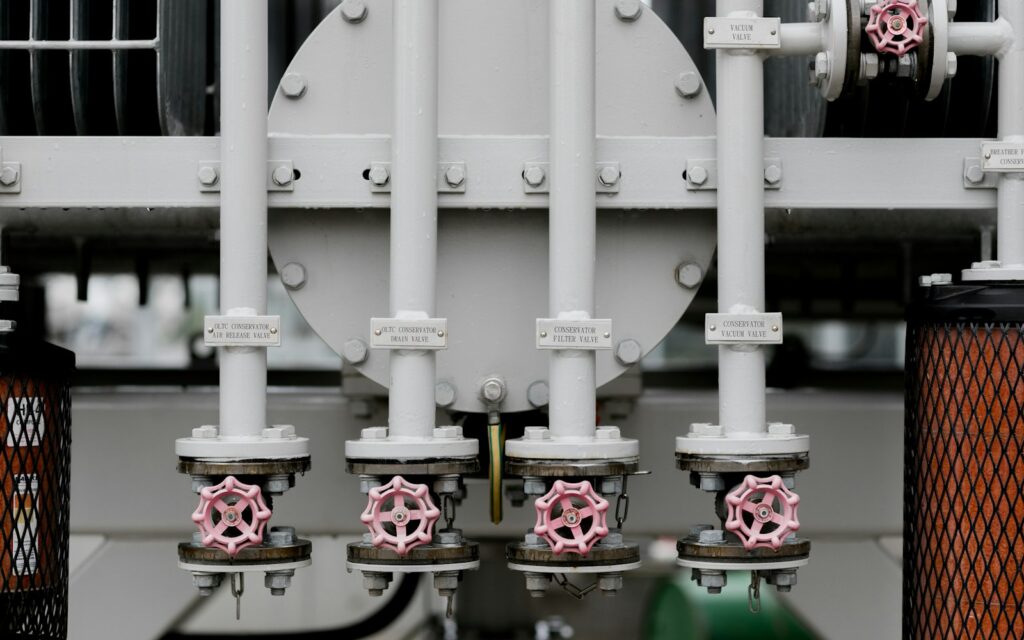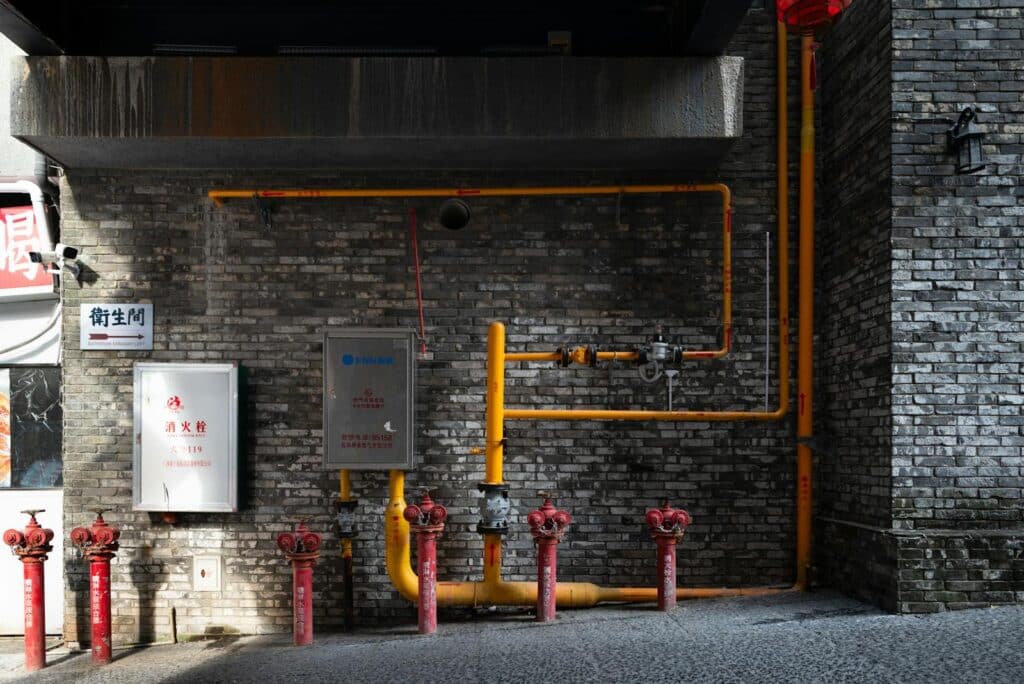When it comes to powering your home or business, natural gas is an efficient, cost-effective, and environmentally friendly energy source. From gas stoves and water heaters to HVAC systems and more, gas-powered appliances are essential to comfortable living. But before enjoying their benefits, there’s one essential step to undertake – gas line installation.
This guide will take you through everything you need to know about gas line installation, from understanding the process to choosing the right professional. Whether you’re installing a new line for a gas stove or extending an existing gas line to accommodate additional appliances, this article covers all the details.

Photo by Gez Xavier Mansfield on Unsplash
What is Gas Line Installation?
Gas lines serve as the vital infrastructure for delivering natural gas or propane to various appliances and systems in your home or business. Here are the key roles and uses of a gas line:
Fueling Heating Systems
Gas lines provide a reliable supply of natural gas to power heating systems such as furnaces and boilers. This ensures your home stays warm during colder months, offering an efficient and cost-effective way to maintain a comfortable indoor environment.
Powering Water Heaters
Water heaters often rely on gas lines to provide the energy required to heat water quickly and effectively. Gas-powered water heaters are known for their efficiency, making them a popular choice in many households.
Running Kitchen Appliances
Gas lines are commonly used to supply energy to kitchen appliances, such as stoves, ovens, and gas ranges. Professional chefs often prefer gas-powered cooking appliances due to their precise temperature control and consistent heat distribution.
Supporting Outdoor Amenities
Many outdoor features, including gas grills, fire pits, and patio heaters, depend on a gas line connection. These amenities create a more enjoyable outdoor space, perfect for entertaining or relaxing in comfort.
Driving Backup Generators
A gas line can connect to a standby generator, ensuring a steady supply of energy during power outages. This is especially important for maintaining critical systems and appliances in emergencies.
Enhancing Fireplaces
Gas-powered fireplaces provide all the warmth and ambiance of traditional wood-burning models with the added benefits of convenience and cleanliness. A gas line allows you to enjoy a cozy fire with just the flip of a switch.
Gas lines are essential for modern living, enabling energy-efficient solutions for homes and businesses alike. Proper installation and maintenance ensure reliable operation, safety, and long-term cost savings.
Benefits of Natural Gas and Gas-Powered Appliances
Gas-powered appliances offer numerous advantages, including:
- Cost efficiency: Natural gas is typically more affordable than other energy sources like electricity or propane, offering long-term savings on energy bills.
- Reliable heating: Gas-powered systems provide consistent warmth for heating and hot water, even during power outages.
- Energy efficiency: Natural gas appliances often consume less energy, making this a sustainable option for homeowners.
- Versatility: Whether it’s for cooking on a gas stove, powering a gas dryer, or keeping your home cozy with a gas-powered furnace, natural gas is an adaptable energy source.
The Gas Line Installation Process
Installing a gas line is a complex job that requires expertise and adherence to safety protocols. Here’s a breakdown of the typical installation process:
1. Planning and Design
Start by determining your gas requirements. Identify the location and number of appliances you wish to connect, such as a gas stove, range, water heater, or air conditioning system. Consider key factors like:
- Total BTU requirements of the connected appliances.
- Meter location for ease of connection to the main line.
- Pipe length and materials necessary for the project.
- Local codes and permits, which dictate installation specifics.
A licensed plumber or contractor will use tools like a measuring tape to map out the best route for installing the gas line, ensuring the connection to the main supply.
2. Permits
Before starting the installation process, you’ll need to secure the required permits from your local government or building authority. This ensures that the installation meets safety and building code standards. These permits often cover details such as safety clearances, pipe materials, and recommended pressure settings.
3. Excavation or Access to Existing Lines
For new installations, contractors may need to excavate sections of your property to connect your home to the main gas line. If expanding an existing gas line, they will inspect its condition, determine the pressure, and plan the connection accordingly.
4. Installation of the Gas Line
Your contractor will use high-grade pipes, valves, and fittings to assemble the line following the specified design, which usually requires pipe wrenches and other specialized tools. Popular materials for gas piping include:
- Steel for durability in outdoor environments.
- Copper or polyethylene for flexibility indoors or underground.
Each connection must be secure, accurate, and sealed to prevent potential gas leaks.
5. Testing and Inspection
Once the line is installed, a licensed professional will conduct comprehensive testing to ensure that the system is secure and functioning correctly. This often includes:
- Pressure testing to check for leaks.
- Inspection by a building inspector to confirm compliance with safety codes.
- Verification that all appliances are working properly with the system.
6. Final Steps
After the inspection, the gas system is ready for use. Contractors will provide detailed instructions for maintaining safety, troubleshooting minor issues, and contacting the utility company for any concerns.

Photo by Nishino Minase on Pexels
Common Signs Your Gas Line May Have Issues
Identifying problems with your gas line early can prevent serious safety hazards and costly repairs. Here are some common signs that your gas line may be experiencing issues:
Unusual Smell
One of the most noticeable signs of a gas line issue is the smell of rotten eggs or sulfur. Natural gas is odorless, but utility companies add this distinctive scent as a safety measure. If you detect this smell, it could indicate a gas leak and should be addressed immediately.
Hissing Sounds
If you hear a hissing or whistling sound near your gas line, it could signify a leak. Gas escaping through a damaged line can create these sounds, often noticeable at connection points or along the piping.
Dead or Dying Vegetation
Gas leaks can affect plant life. If you notice patches of dead grass, plants, or shrubs in an otherwise healthy area, it could be a sign that gas is escaping from an underground line.
Increase in Utility Bills
A sudden or unexplained spike in your gas bill could indicate a leak. If your usage hasn’t changed but costs have risen, it’s worth having your gas line inspected.
Gas Appliance Malfunctions
Appliances powered by natural gas, such as stoves, water heaters, and fireplaces, may operate inefficiently or stop working altogether if there’s an issue with the gas line. Pay attention to reduced performance or failure to light.
Bubbles in Standing Water
If you notice bubbles forming in puddles or other standing water near your home, it could indicate a gas leak beneath the surface. This is a clear sign that immediate investigation is needed.
Corrosion or Rust on Gas Lines
Visible signs of corrosion or rust can weaken gas pipes and lead to leaks. Regular inspections are essential to identify and address these issues early.
If you encounter any of these warning signs, it’s crucial to act quickly by contacting a licensed professional to inspect and repair your gas line. Always prioritize safety and never attempt to fix gas line issues on your own.
Key Considerations in Gas Line Installation
Licensed Professionals
Gas line installation is not a DIY project. Always hire a licensed contractor or licensed plumber experienced in gas installations. This ensures compliance with local regulations and minimizes safety risks.
Cost Estimate
Costs for gas line installation vary based on factors such as:
- Pipe length and materials used.
- Labor charges of contractors.
- Whether you’re installing a single gas line or a more complex system.
- Additional costs for permits or excavation.
Other Utilities
Ensure coordination with other utilities like water and electricity. Avoid damaging existing infrastructure during installation.
Gas Leaks and Safety
Gas leaks are a serious risk. Look out for these signs:
- A distinct sulfur or rotten egg smell.
- A hissing sound near gas pipes or appliances.
- Visibly damaged gas piping or valves.
If you suspect a gas leak, shut off the gas supply immediately, ventilate the area, and contact a professional.
Maintenance and Troubleshooting
Maintaining your gas piping and appliances ensures they remain safe and efficient. Perform regular checks for signs of wear or leaks, and schedule professional inspections as recommended. Clean gas fixtures like stoves and ranges to keep them operating efficiently.
If you encounter any issues with your gas system, such as appliances not receiving sufficient pressure or unusual noises, contact a trusted contractor for a diagnostic assessment.
Why a Professional Installation Matters
A professional gas line installation gives you peace of mind, ensuring:
- Compliance with local codes for safety and quality.
- Proper connection of appliances to the system.
- Accurate pressure settings for efficiency and durability of your gas-powered appliances.
Professional services also help you avoid additional costs from potential errors in DIY attempts.

Why Choose GAE Plumbing & Heating for Gas Line Installation?
GAE Plumbing & Heating stands out as the trusted choice for gas line installation due to our unparalleled expertise, commitment to safety, and dedication to customer satisfaction. Our team of licensed and experienced professionals ensures that every project is completed to the highest standards of quality and compliance. We take safety seriously, performing thorough inspections and using advanced techniques to minimize risks during installation.
With years of industry experience, GAE Plumbing & Heating delivers reliable and efficient service tailored to your specific needs. Whether it’s a small residential project or a large commercial installation, we provide clear communication, upfront pricing, and timely execution. When you choose GAE Plumbing & Heating, you’re choosing peace of mind knowing your gas line installation is handled by experts who prioritize your safety and comfort.
Helpful Resources for Gas Line Installation
Here are seven reliable resources, links, and websites to help you with gas line installation, safety practices, and finding certified professionals:
- U.S. Occupational Safety and Health Administration (OSHA): Visit OSHA’s website for guidelines and safety standards related to gas line installation and handling natural gas systems.
- American Gas Association (AGA): The AGA provides resources on natural gas safety, industry standards, and best practices for homeowners and professionals.
- Energy.gov – Natural Gas Basics: Learn about natural gas usage, efficiency, and safety tips on this official U.S. Department of Energy website.
- National Fire Protection Association (NFPA): Check NFPA’s standards for gas piping systems and fire safety protocols for residential and commercial properties.
- Find a Licensed Contractor – Angie’s List: Use Angie’s List to locate qualified and reviewed professionals for gas line installation and maintenance in your local area.
- Safe Gas Line Installation Tips – HomeAdvisor: Read HomeAdvisor’s detailed guides and connect with professionals experienced in gas line repair, installation, and inspection.
- Call 811 – Know What’s Below: Before starting any installation project involving digging, use the 811 service to identify underground utility lines and avoid accidents.
These resources can guide you through understanding gas line installation processes and ensure that your project is safe, compliant, and efficient.
Take Action for Safe, Efficient Gas Line Installation
Installing or upgrading a gas line is a major investment that can greatly enhance your home’s comfort, efficiency, and safety. By working with a licensed contractor, following local regulations, and carefully planning the installation process, you can ensure a hassle-free experience.
If you’re ready to get started, contact a licensed professional today to discuss your gas line needs. Professional guidance will help you determine the most cost-effective solution for connecting your appliances to natural gas. Gauge your home’s energy potential today and start saving with a safe gas-powered system.

